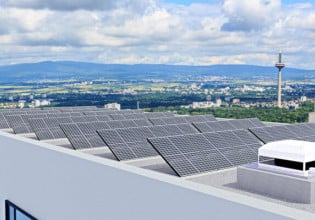Bifacial Solar Panels: Dual-Sided Sustainability
This article explores bifacial solar panels— how they work, why they are important to solar growth, and applications benefiting most from their installation.
Solar power is increasingly important in the global energy mix, now accounting for 4.2% of total power generation. It is also arguably one of the most exciting areas of development, with countless technological advancements promising to turn it into a market leader in the coming years.

Image used courtesy of Pexels
Understanding Bifacial Solar Panels
When you imagine a solar panel, you probably think of the traditional monofacial panel in many solar arrays, people's homes, and commercial buildings. This panel type is typically fixed against a surface like a roof. The exposed side captures energy from the sun and turns it into electricity.
Bifacial solar panels take a different approach. As the name suggests, bifacial panels feature glass surfaces on both sides, capturing sunlight from both sides. Apart from this distinct difference, bifacial panels are practically identical to monofacial panels and typically use monocrystalline solar cells to achieve optimum sun energy capture.
Advantages of Bifacial Panels
The clear advantage of bifacial panels is the increased surface, which can be used to capture sunlight. Bifacial panels capture sunlight in three ways:
Sunlight that shines directly on the panel (like monofacial panels)
Sunlight that misses the panel but bounces off a nearby surface onto the front or rear side of the panel
Sunlight that passes through the panel and bounces off a reflective surface and back onto the rear side of the panel
Of course, the front of the panel will typically be south or south-west facing and gain the greatest level of sun exposure. However, the dual surface nature of the panel enables potentially lost sun energy to be recaptured. Although bifacial panels are usually a little more expensive than monofacial panels, this cost is typically well covered by the panel's extra energy.
Bifacial panels feature two tempered glass sides, which are UV and weather-resistant with no frame. This is likely to make the panels more robust and increase lifespan compared to monofacial panels. Increased lifespan is also achieved due to reduced potential induced degradation (PID), which occurs when an electrical current strays from its intended path, resulting in potential corrosion of the panel frame over time.
Bifacial panels will usually have a higher efficiency level in any environment but are particularly beneficial in environments where highly reflective surfaces are common, such as snowy climates.

Image used courtesy of Pexels
Of course, there are downsides to bifacial panels. We have already mentioned how this panel type is typically more expensive than monofacial panels. Due to their added complexity, they can be slightly more costly to install.
Bifacial Panels: Applications
The potential application of bifacial solar panels is huge. However, they aren’t always the best option. This is usually the case where you cannot apply panels in an elevated position, such as installing panels directly onto a roof’s surface. Without elevation, there is little opportunity for light to reflect off the surface below the panel, minimizing the benefit of having two sides.
Some scenarios where bifacial panels are ideal include:
- Commercial solar farms with flexible installation options
- Residential installation where panels can be mounted off the ground
- In carports where panels can offer vehicles protection from the sun
- In outdoor shelters such as picnic areas where panels can provide shade
- For unique applications such as sound barriers
- In situations where space is at a premium
Economic and Environmental Impact
Bifacial solar panels open the door for greater economic and environmental benefits. When installed in optimal conditions, bifacial solar panels can increase energy yields and drive greater returns on investment.
Ultimately, their application could improve the viability of solar and speed up the replacement of non-sustainable energy production methods. They could also benefit the environment due to their increased efficiency per unit of area, limiting the need to dedicate land for larger solar panel arrays and reducing the number of panels that need to be manufactured.
Comparative Analysis: Bifacial vs. Monofacial
Table 1 compares and contrasts the advantages, disadvantages, and applications of bifacial and monofacial solar panels.
Table 1. Bifacial vs. monofacial solar panels
|
Bifacial |
Monofacial |
|
More expensive to produce |
Cheaper to produce |
|
More expensive to install |
Cheaper to install |
|
More efficiency (11-23% more efficient than similar monofacial panels) |
Less efficient |
|
Require mounting into an elevated position |
Typically applied directly to surfaces such as on a rooftop |
|
Ideal for areas where space is sparse |
Suitable for areas with greater space availability |
|
Higher performance in areas with highly reflective surfaces |
Great performance in almost any area |
Like many options in solar energy production, there is a trade-off between cost and efficiency. Whether bifacial solar panels are right for a specific scenario will depend widely on budget and their ability to be installed in an optimal position.
Bifacial Solar Panels Summary
Bifacial panels are an exciting technology that could be applied in many scenarios. Their ability to increase the amount of sunlight absorbed without increasing the panel size makes them an ideal solution in areas where space is at a premium.
Technologies like this will play a crucial role in growing the solar energy market and supporting a global shift away from energy production, which generates high emissions and is harmful to the environment.
Combining emerging technologies, such as bifacial solar panels and tandem solar cells, could see huge improvements in panel efficiency in the coming years, making them a significant competitor to other renewables, such as wind and hydropower.






